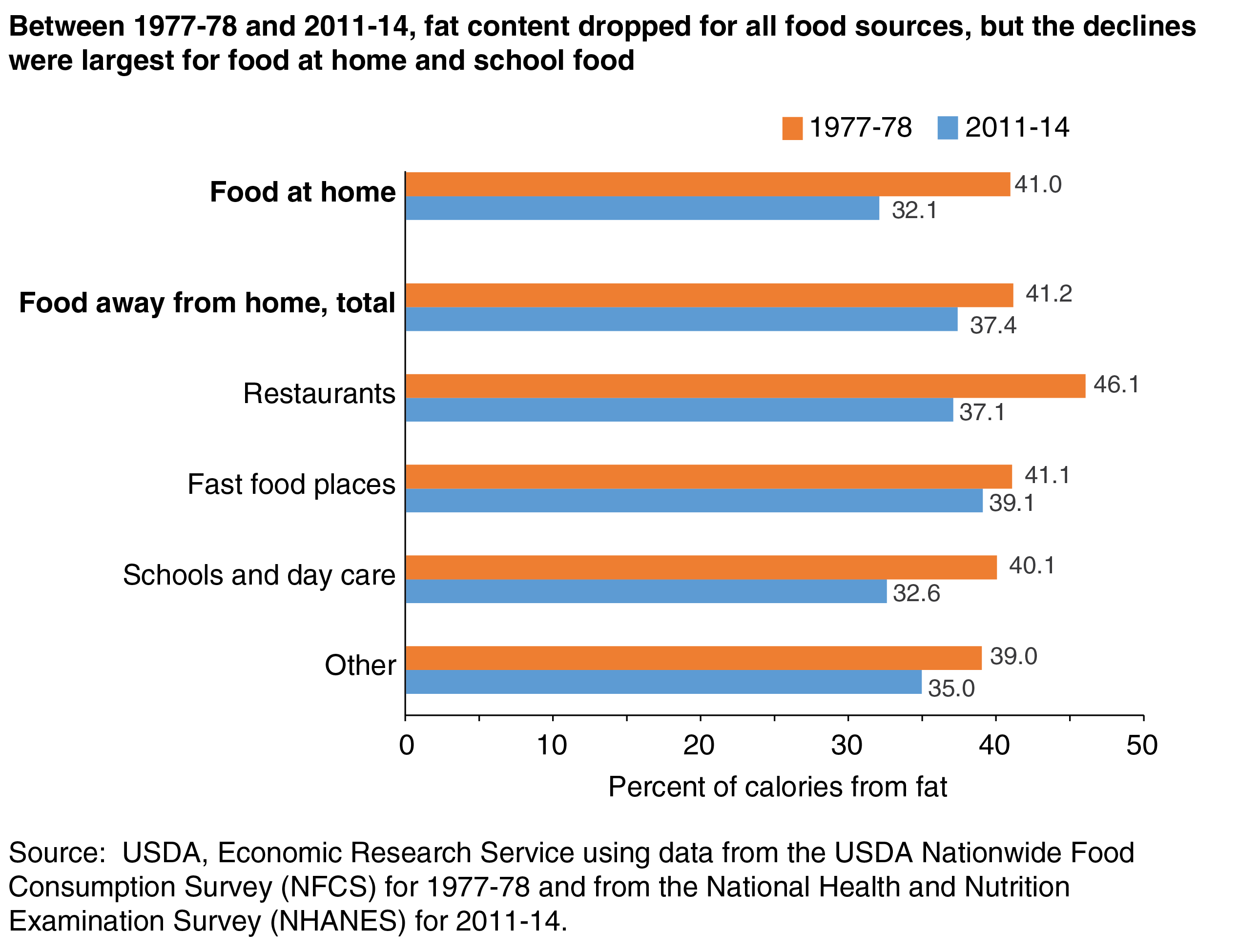
Both At Home and Away, Americans Are Choosing More Lower Fat Foods Than They Did 35 Years Ago
- by Joanne Guthrie and Biing-Hwan Lin
- 10/1/2018
Whether consumed in restaurants or as take-out or delivery meals, food prepared away from home is now a ubiquitous part of the American diet. In 1977-78, away-from-home meals and snacks accounted for 17.8 percent of Americans’ calories. By 2011-14, these foods accounted for 33.7 percent of calories. Consumers may make different choices at the grocery store than they would when eating out—choices that can affect both consumers’ diets and the decisions made by agricultural producers, food manufacturers, and restaurant operators. A recent ERS analysis found that between 1977-78 and 2011-14, the fat content of at-home foods consumed by Americans declined more than the fat content of away-from-home foods.
Food at home and food away from home are defined by where the food was purchased or obtained. Food at home includes foods purchased from supermarkets, smaller grocery stores, supercenters, or other retailers, including prepared or semi-prepared items such as rotisserie chicken or bagged salad. Food away from home includes foods obtained from full-service restaurants with wait staff, fast-food establishments with no wait staff, schools or day care facilities, and a catchall “other” subcategory that includes vending machines, work place snack trays, Meals on Wheels, meals at someone else’s home, and other away-from-home sources.
The fat content of food obtained from at-home and away-from-home sources was essentially identical in 1977-78, with 41 percent of calories in those foods coming from fat. By 2011-14, the fat content of food at home had dropped to 32.1 percent of calories, below the upper limit of 35.0 percent recommended by the National Academies of Sciences’ Food and Nutrition Board. Over the same period, the fat content of food away from home had dropped less sharply to 37.4 percent of calories in those foods. Changes in fat content can occur because of different choices being made by consumers (e.g., choosing a grilled chicken sandwich instead of fried chicken), changes in product formulation (e.g., food manufacturers developing a lower fat lasagna), or both. Packaged food purchased in retail stores carried the Nutrition Facts label, which lists grams of fat in the product and calories from fat. Easy access to this information may have led to more health-conscious purchases by consumers and also may have motivated food companies to develop lower fat products.
Changes in fat content varied for the different away-from-home categories. The fat content of fast food changed very little—from 41.1 percent of calories in 1977-78 to 39.1 percent in 2011-14. The fat content of school meals, on the other hand, fell almost as much as food at home, going from 40.1 to 32.6 percent of calories. School food consists primarily of meals served as a part of USDA’s National School Lunch and Breakfast Programs. Those meals are required to meet nutrition standards established by USDA.
This article is drawn from:
- Saksena, M., Okrent, A., Anekwe, T.D., Cho, C., Dicken, C., Effland, A., Elitzak, H., Guthrie, J., Hamrick, K., Jo, Y., Lin, B., Mancino, L., McLaughlin, P.W., Rahkovsky, I., Ralston, K., Smith, T.A., Stewart, H., Todd, J.E., Tuttle, C. & Hyman, J. (2018). America’s Eating Habits: Food Away From Home. U.S. Department of Agriculture, Economic Research Service. EIB-196.


